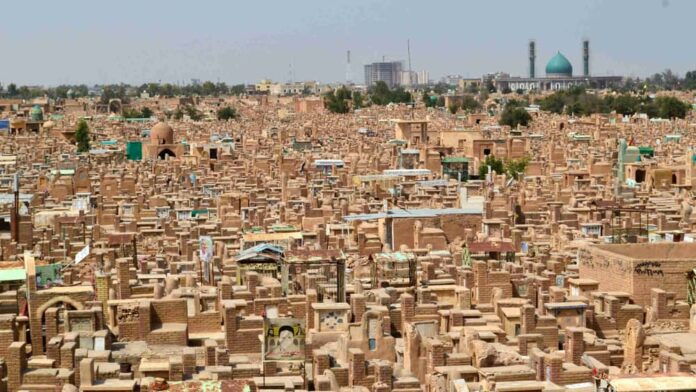Wadi Al-Salam: The world’s largest cemetery
Nestled in the holy city of Najaf, Iraq, Wadi Al-Salam Cemetery stands as a monumental testament to the beliefs and traditions of Shia Islam. Covering an impressive 1,485.5 hectares (3,677 acres), this vast expanse is not merely a burial site; it is the largest cemetery in the world, cradling an estimated five million souls. As “Wadi Al-Salam,” meaning “Valley of Peace,” it embodies a profound connection to the afterlife and the enduring legacy of those interred within its boundaries.
For over 1,400 years, Wadi Al-Salam has served as the final resting place for Muslims from around the globe, particularly those of the Shia faith. Its proximity to the revered shrine of Imam Ali ibn Abi Talib, a key figure in Shia Islam and cousin to the Prophet Muhammad, draws families from various regions, especially Iran and Iraq, seeking solace and spiritual closeness to their loved ones. The pilgrimage to Najaf, where the shrine resides, is often complemented by a visit to the cemetery, creating a sacred journey filled with reflection and reverence.
The origins of Wadi Al-Salam trace back to the 7th century, shortly after Imam Ali’s death. It is mentioned in Islamic texts as a place where souls gather, underscoring its spiritual importance. According to Shia beliefs, burial in this hallowed ground confers spiritual proximity to Imam Ali, offering potential intercession on the Day of Judgment. As Idris noted, “Being buried here is considered an honor,” and it reflects the deep-seated traditions that have shaped this sacred space over centuries.
Wadi Al-Salam is characterized by its unique burial practices, where the deceased rest in elaborate crypts and tombs, often in family plots. This layout not only reflects a person’s social standing but also their familiar connections, with many graves showcasing intricate carvings and inscriptions from the Quran. The cemetery resembles a vast city of the dead, where tombs densely line the landscape, creating a mesmerizing maze that intrigues visitors and historians alike.
The burial chambers, often deep underground, house multiple generations, intertwining life and death in a profound narrative. As Hamza Idris eloquently expressed, “This cemetery is not just about death; it’s about how life continues through the memories and legacies of those who have passed.”
For the residents of Najaf, Wadi Al-Salam is more than a cemetery; it is a part of their daily lives. Families routinely visit the graves of their ancestors, maintaining a vibrant connection that transcends death. This relationship is so integral that local businesses have evolved around the cemetery, providing jobs in grave-digging, tombstone carving, and maintenance.
READ ALSO : Embrace the Shield of Suratul Al-Falaq: Your guide to divine protection
Visitors often find that their pilgrimage to Imam Ali’s shrine is incomplete without paying respects at Wadi Al-Salam. The atmosphere is imbued with a sense of reverence, as mourners engage in rituals, recite Quranic verses, and reflect on the transitory nature of life. The connection between the living and the dead here is palpable, reminding us of the shared humanity that binds us all.
Despite its sacred status, Wadi Al-Salam faces challenges. As demand for burial plots rises, concerns over sustainability and overcrowding grow. The cemetery has witnessed damage due to Iraq’s turbulent history, yet it remains a symbol of resilience and faith for Shia Muslims.
Efforts to maintain and organize the site are crucial to preserving its sanctity and accommodating future generations who wish to honor their loved ones in this hallowed ground. As the cemetery continues to evolve, it embodies the complexities of life, death, and faith, illustrating the enduring legacy of those interred within its bounds.
Wadi Al-Salam is more than just the largest cemetery in the world; it is a profound spiritual haven, a living monument to the deep reverence that Shia Muslims hold for their faith and the afterlife. The stories of generations, etched in stone and memory, create an intricate tapestry of life and death, reflecting a culture that cherishes the past while looking toward the future.
As we contemplate the significance of this eternal resting place, we are reminded that in Wadi Al-Salam, life and death coexist in a sacred harmony—a timeless connection that transcends the boundaries of our mortal existence.
Written by Sakinat Musa Abubakar, Editor at Neptune Prime
Follow the Neptune Prime channel on WhatsApp: https://whatsapp.com/channel/0029Va74ZvU2v1IqKByXoX3d
Do you have breaking news, interview request, opinion, suggestion, or want your event covered? Email us at neptuneprime2233@gmail.com


